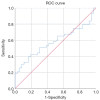Analysis of the guidance value of 3D ultrasound in evaluating endometrial receptivity for frozen-thawed embryo transfer in patients with repeated implantation failure
- PMID: 32953744
- PMCID: PMC7475420
- DOI: 10.21037/atm-20-5463
Analysis of the guidance value of 3D ultrasound in evaluating endometrial receptivity for frozen-thawed embryo transfer in patients with repeated implantation failure
Abstract
Background: Repeated implantation failure (RIF) is currently believed by some scholars to be mainly related to the poor endometrial receptivity. Three-dimensional (3D) ultrasound, as a noninvasive examination, has attracted the most attention. This paper further discusses whether 3D ultrasound of the endometrial receptivity index has guidance value in the evaluation of pregnancy outcomes in patients with RIF following frozen-thawed embryo transfer.
Methods: A total of 79 patients with RIF were retrospectively analyzed. These 79 patients which were confirmed by the transvaginal ultrasonography detection comprised 36 cases of intrauterine pregnancy, which were included in the pregnancy group, and 43 cases with biochemical pregnancy (the HCG in blood or urine is only transient and can be detected by clinical biochemical methods. The pregnancy sac cannot be seen under ultrasound) or negative results of human chorionic gonadotropin (HCG) examination, which were included in the non-pregnancy group. The endometrial thickness, uterine volume, sub-endometrial blood flow type, pulsatility index (PI) and resistance index (RI) of the spiral artery; the RI and PI of the uterine artery; and the peak systolic velocity/end diastolic velocity (S/D) of the two groups were measured and analyzed.
Results: (I) There were no significant differences in the age, infertility years, body mass index (BMI), anti-Müllerian hormone (AMH), endometrial thickness on the hCG injection day, estradiol (E2), and progesterone (P) between the pregnant and non-pregnant groups (P>0.05). (II) There were no significant differences in the endometrial thickness, uterine volume, and RI and PI of the uterine artery on the day before the implantation between the two groups (P>0.05). (III) There was statistical difference in the sum of the S/D of the two uterine arteries between the two groups (P<0.05) with a cutoff value of 14.47 (P<0.05). (IV) The RI and PI of the spiral artery in the non-pregnancy group were lower than those in the pregnancy group, and the difference was statistically significant (P<0.05). (V) The differences in the endometrial classification and subendometrial blood flow classification between the two groups were statistically significant (P<0.05).
Conclusions: Ultrasonographic endometrial blood flow classification, spiral artery blood flow parameters, and uterine artery blood flow parameters can be effective indexes for evaluating endometrial receptivity, and they have a certain clinical significance in evaluating the pregnancy outcome of RIF patients after retransplantation.
Keywords: 3D ultrasound; endometrial receptivity; frozen-thawed embryo transfer; repeated implantation failure (RIF).
2020 Annals of Translational Medicine. All rights reserved.
Conflict of interest statement
Conflicts of Interest: All authors have completed the ICMJE uniform disclosure form (available at http://dx.doi.org/10.21037/atm-20-5463). The authors have no conflicts of interest to declare.
Figures




Similar articles
-
The role of three-dimensional power Doppler ultrasound parameters measured on hCG day in the prediction of pregnancy during in vitro fertilization treatment.Eur J Obstet Gynecol Reprod Biol. 2016 Aug;203:66-71. doi: 10.1016/j.ejogrb.2016.05.016. Epub 2016 May 20. Eur J Obstet Gynecol Reprod Biol. 2016. PMID: 27254812
-
Comparison of uterine, endometrial and subendometrial blood flows in predicting pregnancy outcomes between fresh and frozen-thawed embryo transfer after GnRH antagonist protocol: a retrospective cohort study.J Obstet Gynaecol. 2023 Dec;43(1):2195937. doi: 10.1080/01443615.2023.2195937. J Obstet Gynaecol. 2023. PMID: 37029723
-
Detection of endometrial and subendometrial vasculature on the day of embryo transfer and prediction of pregnancy during fresh in vitro fertilization cycles.Taiwan J Obstet Gynecol. 2014 Sep;53(3):360-5. doi: 10.1016/j.tjog.2013.05.007. Taiwan J Obstet Gynecol. 2014. PMID: 25286791
-
Assessment of uterine artery and arcuate artery blood flow by transvaginal color Doppler ultrasound on the day of human chorionic gonadotropin administration as predictors of pregnancy in an in vitro fertilization program.Akush Ginekol (Sofiia). 2012;51(2):55-60. Akush Ginekol (Sofiia). 2012. PMID: 23234017
-
The first three weeks assessed by transvaginal color Doppler.J Perinat Med. 1996;24(4):301-17. doi: 10.1515/jpme.1996.24.4.301. J Perinat Med. 1996. PMID: 8880627 Review.
Cited by
-
The Disorders of Endometrial Receptivity in PCOS and Its Mechanisms.Reprod Sci. 2022 Sep;29(9):2465-2476. doi: 10.1007/s43032-021-00629-9. Epub 2021 May 27. Reprod Sci. 2022. PMID: 34046867 Review.
-
Ultrasound‑assessed endometrial receptivity measures for the prediction of in vitro fertilization‑embryo transfer clinical pregnancy outcomes: A meta‑analysis and systematic review.Exp Ther Med. 2023 Aug 3;26(3):453. doi: 10.3892/etm.2023.12152. eCollection 2023 Sep. Exp Ther Med. 2023. PMID: 37614426 Free PMC article.
-
Comparison and correlations between findings of hysteroscopy and vaginal color Doppler ultrasonography for detection of uterine abnormalities in patients with recurrent implantation failure.Open Med (Wars). 2025 Jun 13;20(1):20251226. doi: 10.1515/med-2025-1226. eCollection 2025. Open Med (Wars). 2025. PMID: 40534632 Free PMC article.
-
Association of Early-to-Mid-Luteal Serum Estradiol Levels with the Outcomes of Hormone Replacement Therapy-Frozen Embryo Transfer: A Systematic Review and Meta-Analysis.Reprod Sci. 2025 Aug 13. doi: 10.1007/s43032-025-01952-1. Online ahead of print. Reprod Sci. 2025. PMID: 40802132 Review.
-
The predictive value of uterine artery Doppler in the success rate of pregnancy from the first frozen embryo transfer during the implantation window.BMC Pregnancy Childbirth. 2023 Nov 30;23(1):825. doi: 10.1186/s12884-023-06150-y. BMC Pregnancy Childbirth. 2023. PMID: 38037011 Free PMC article.
References
LinkOut - more resources
Full Text Sources
Research Materials
Miscellaneous
